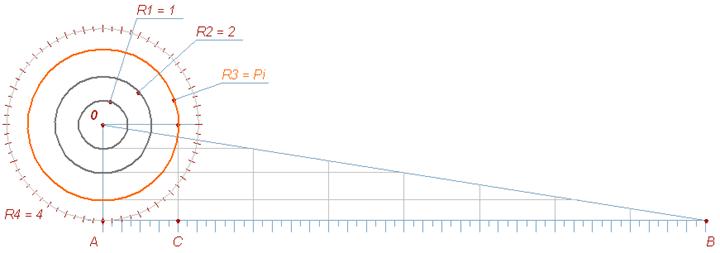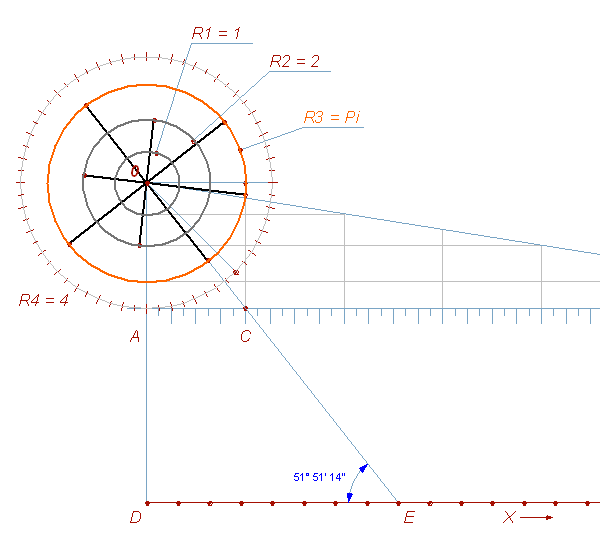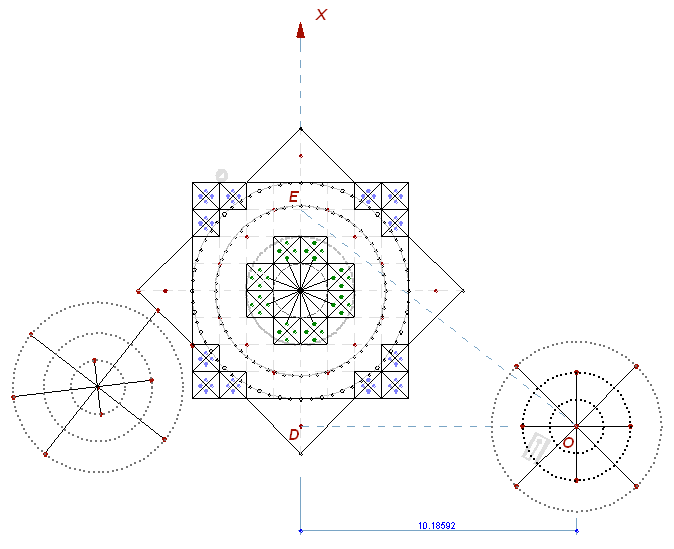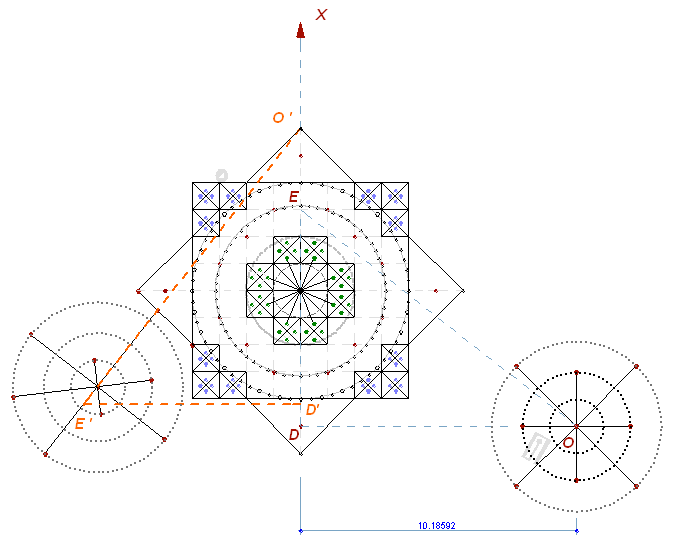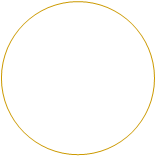

|
“Estrella” - composition analysis |
|
Ggeoglyphs in the Nazca mountains - is it just a simple ornament or the plan |

|
Chapter 4. Circles and their perimeters. |
|
V. Kulikov |
|
Now, using the previously discovered logical vectors and compositional patterns of the system, lets try connect to the general "machine" the remaining elements of the geoglyph - two groups of concentric circles, located outside the star. The geometry rules of the star will find their confirmation again in the new interesting "coincidences".
Fig. 1 It is striking that the circles have the same radius, as we see inside the main star, and are placed on the coordinate axes.
* After the careful study of the pictures, we see, that the third circle, both inside and outside the star, is slightly more than a circle with a radius of 3. So I assumed that the radius is equal to Pi. For the present time, I do not see what it can influence on further, then more "interest" occurs, as it looks like a photographic reality.
Why "Pi" again? This number is the transmitting coefficient between the polar and rectangular systems.
Fig. 2
Fig. 2 AB = 8 * Pi = 25.1327412287183459077011470662360230735773551950008465677995567 ... The 64-gon, built with the help of the matrix , with a modular side, is almost equal to its circumscribed circumference, the radius of which is already known (Chapter 3 ,Fig. 5). For the 64-sided polygon with the sides equal to 1, this radius will be 10.19001. (Circumference will be equal to 64.02572, while the value of Pi - 3.14033). The accuracy is not much high, but if you continue to divide the polygon, you can get any desired accuracy. For example, a 2048-gon shows radius of the circle = 10.18592, perimeter - 64.0003 and the number of Pi with an accuracy of up to 5 decimal points. Let's draw down the radius (10.18592) from the point "O" , and then lay out the length, equal to 64 modules. We shall get the following:
Fig. 3 Here, the segment size (1/64 of the circle) is equal to the modular unit. The correspondence of angular size of the polar system with a modular unit of the rectangular system is established.
Fig. 4 We see, that DE length is equal to 8 units (1/8 of 64), which is the side of our square, or the side of the matrix octagon, shown on the Fig. 22 . With the help of this "converter", we can find the length of the circle with the required radius. Let's lay out the radius along the axis OD until the intersection with OX. (where DX = 64). Conversely, we can get the radius of the circle with the desired length: lay out the length along the DX and lift up until the intersection with OX. The ordinate of this point will be the radius. Now - about the coincidence. The location of the circles, located outside the star, satisfy these rules!
Fig. 5 Here, only the axis have turned. OD = radius of the circle with perimeter of 64, deployed along the DX axis. The right group of the circles is fixing the radius of the circle, constructed by the series of polygons on the square 16x16. Now, let's turn the triangle ODE around point D, and fit O with the vertex, thus receiving the triangle O'D'E ':
Fig. 6 Here, similarly to Fig. 4, E'D '= 8 or 1/8 of the perimeter of a circle with radius O'D'. The left group of the circles captures the angle that assigns the 1/8 of the circumference (E'D ') and its radius and (O'D'). It is difficult to determine the location of the circles with an accuracy up to 5 decimal digits, just looking on the photo of the geoglyph. But I was trying to check many times the offset OD, and the passage of the ray O'E '. Therefore I can confidently speak about the accuracy to the nearest tenth decimal points (and this is approximately the thickness of the geoglyph's line, what corresponds to the the limit of geoglyph accuracy). OD - about 10.2 - 10.3 (by module) - can be seen on the air images, taken in the direction, perpendicular to that line. In this case, it is possible to lay out the modul value without perspective distortion. The topographs, in this case, will also cause some distortion along the Y axis, which is not much affect on the distance along the X axis.
But what for this accuracy? After all, the circles on the pattern do not have any exact binding. Maybe this fact is not accidental? The values, they are pointing on, are variable, depending on the stage of building the polygons. A 32-gon will have one radius, while the 128-gon - another one. It is important to mention, that "here we have the radius of the circle, built on a square 16x16". And the accuracy with which this was done - just a matter of technique. The same thing with the another circle: it does not have any direct correlation, indicating on the "floating" value, depending on the stage of the system development. But the axis, starting from the point E on the geoglyphs is tied to the only one point. It is drawn up to the side of the diagonal square and confidently goes further up to the point O ', which is the top of the star. Such "binding" can be regarded as an anchoring of vertex of the variable angle E'O'D '. This axis, as well as the line OE, shown on the Fig. 4, is the same variable pointer. It may indicate to 1/8 or 1/4 of the entire circumference or perimeter by changing the angle, but it always will remain at the point O. In this case the ray indicates on the angle, cutting off the 1/8 of the circumference perimeter, the radius of which is indicated by the right circles. And the accuracy of this angle will depend on the degree of precision of the radius of the 64 circumference. Therefore, we can assume that here we need the following concept: The circle in the point O indicates on the radius of the circumscribed circle OD with the circle perimeter = 64.
The ray O'E ' is cutting the 1/8 of the circumference as: The Angle (O'E'D '), obtained in this case, is close to 51° 51’ 14”, depending on the accuracy of the location of the OD radius.
|

